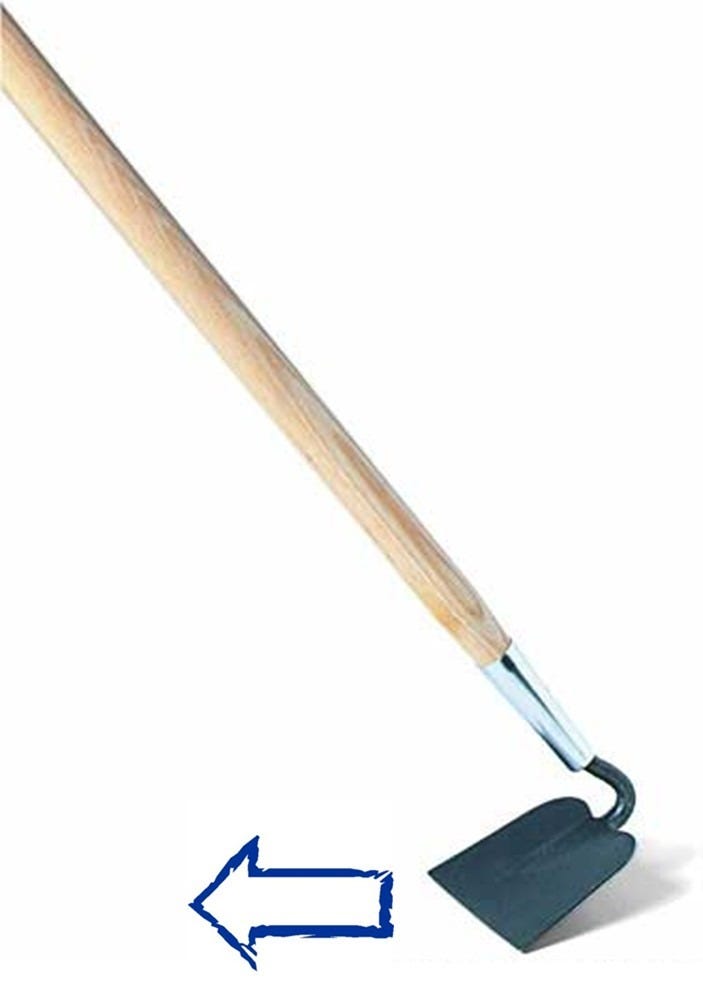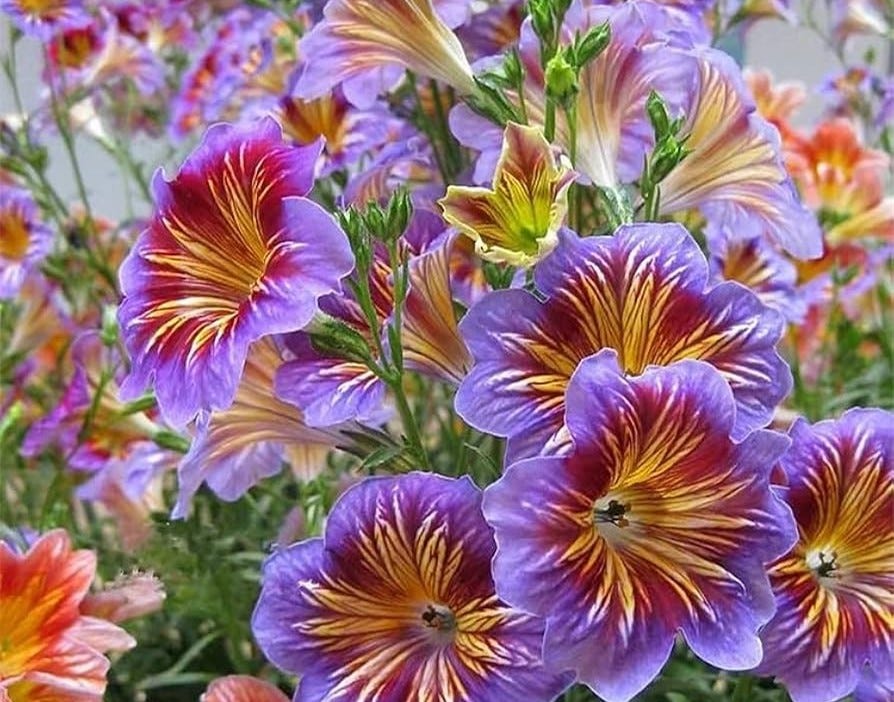MANAGING BINDWEED – THE NASTY “MORNING GLORIES”
Including One of the Most Tenacious, Unrelenting, Wearisome, and Generally Frustrating Weeds to Ever Hound Gardeners
Somehow the name “morning glory” has come to mean a downright pernicious weed (and a host of unprintable descriptives). Everything bearing that name is met with derision and a big “no thanks.” It’s another one of those plant names — such as eucalyptus, juniper, ice plant, and butterfly bush — that have become a generality for all things akin. They become part of phrases such as “all those trashy eucalyptus are the same.” It’s plant stereotyping.
Herein is the sort of thing that pushes me to my soapbox rant, the one about common names. When people show off the beautiful flowering vine that they’ve planted in their garden and tell friends they’ve planted “morning glories,” they’re often met with cries of “Oh no, you’ve made a mistake! Get rid of it quick.” Or someone starts with “I’ve been digging out morning glory for years and I can’t get rid of it,” with a common response of “I plant it every summer and it always dies completely come winter.”
To be balanced, there are, indeed, trashy species of eucalyptus. But there are many, more beautiful, first-rate, garden-specimen quality Eucalyptus trees and shrubs. Similarly, the name “morning glory” belongs to many worthy ornamental species, most within four species* and some hybrid groups, of the genus Ipomoea; they are annuals and tropical (tender) perennials, the latter of which are either killed completely in winter or are short-lived even in the mildest climates.
But, as with eucalyptus, “morning glory” has been applied to a handful of other ornamental plants that also get out of hand, do it year after year, and become genuine PITAs. Plus there’s a couple of “morning glories” that have never been used as ornamentals. And these last two are the real villains.
Before I describe and provide management details for the two villains, let me quickly offer up some tidbits on the few that are less horrific but still require caution or at least serious scrutiny. The PITAs:
Ipomoea cairica (Coast Morning Glory, Cairo Morning Glory, Mile-A-Minute Vine). A bad guy in Hawaii, California, and the Gulf states.
Ipomoea coccinea (Red Morning Glory, Redstar, Mexican Morning Glory). Although some have considered it a US native, that’s doubtful. A weed of roadsides and other disturbed areas in the south, southeast, and very central states.
Ipomoea corymbosa (Christmas Vine). Another species thought to be native but reported out of range, in disturbed areas (that includes gardens) throughout the southeast US.
Ipomoea hederacea (Ivy-Leaved Morning Glory). Looks like the commonly grown, friendly I. purpurea. A tropical vine popping up throughout much of the U.S., even up to North Dakota.
Ipomoea imperati (Beach Morning Glory, one of several plants with this or similar names). A native plant to the southeastern United States but it can be invasive in some areas, particularly where it has been introduced outside of its native habitat.
Ipomoea indica (I. acuminata, I. learii) (Oceanblue Morning Glory, Blue Morning Glory, Blue Dawn Flower). This is a fairly common “beast” morning glory, usually when unattended, in California.
Ipomoea x leucantha (Hybrid Morning Glory). A natural hybrid “native” to the Southeast US but has popped up slightly north and in the Southwest.
* Ipomoea purpurea (Common Morning Glory). One of the most commonly grown morning glories in home gardens, thought of as an annual, can sometimes persist as a bothersome perennial in the southwest and various counties throughout the East. It’s legally considered “Invasive” in only a couple of states.
Other than the above species, the annual morning glories (other species and hybrids of Ipomoea), are nice.
But then there are actually pesty weeds that are better called “bindweed.” These are the true “Invasive” and “Noxious” weeds (by biological and agricultural definitions).
The nastiest bindweed (“morning glory”) is Convolvulus arvensis, what Weedologists (not a real word) call “Field Bindweed.” It has a pink backing to its smallish white flowers, somewhat grayish leaves, and it’s mostly a ground hugger that grows in almost any soil.
The other troublesome bindweed is Calystegia sepium, the “Hedge Bindweed.” There are several subspecies of this that are native ruderal (pioneering) species and although they can act “weedy” in some areas, they can be neither “Invasive” (meaning to unnaturally invade nature) nor “Noxious” (= a financial impact on farms). Calystegia sepium has no significant pink on the back of its much larger flowers (although some plants have flowers that show some pink on the topsides) and it’s mostly a climber. The twist here is that Calystegia sepium ssp. sepium, introduced from Europe, is a widespread, truly “Invasive” weed in the U.S. As expected, telling the introduced from the native can be difficult; add to that the many other native species of Calystegia (25 in California alone) that can be mistaken, at least superficially, for the weedy European. Many of the native species are worthy garden ornamentals, by the way.
If you hadn’t noticed, neither of these two species are in the same genus as the friendly morning glories, the species of Ipomoea (to be addressed next week).
.
Getting a handle on these two invasive and noxious plants, Field Bindweed and Hedge Bindweed, requires similar basic techniques and “tools,” albeit with some subtle tweakings.
Cutting them off is a good starting point. But whether you dig them or cut/hoe them off (by snipping or shaving across the soil surface; not digging/chopping), these bindweeds will return. The thickened roots of established plants can go many feet down into the ground; it’s rare (impossible?) that a gardener can get “every piece of root.”
The differences in the long-term results of these two practices — digging versus cutting/hoeing — is very important to note.
Tilling, digging, or pulling roots:
pulls up more seeds (of the bindweeds and other species) that have been sitting deep down in your soil and places them closer to the light and warmth they need to germinate and grow. Field bindweed seeds can live for more than 40 years.
creates a bit of “disturbed” soil, the perfect site for the newly-dug up seeds to take a footing. And additional blown-about weed seeds to find haven and take hold.
breaks down the desirably crumbly texture (“good tilth”) of the soil’s surface.
disturbs the roots of nearby plants.
most critically, it disrupts the “edaphon,” the living component of the soil.
Hedge bindweed is best snipped off, near the ground, with sharp shears or husky scissors. Field bindweed is most effectively removed by hoeing properly (running a sharp blade across the soil surface as if “shaving”). Neither of these methods has the detrimental effects of digging, as mentioned previously. Mow/hoe/whack when soil is dry and before the bindweed produces too many flowers (preferably no flowers).

Every time you snip off or hoe off the top foliage, the root system will, of course, force new growth. But in order to do so, it must use some of the foot storage within that thickened, almost bulbous, root system. It can replace that food storage only by producing enough leaves to photosynthesize. Your job is to cut off any new foliage you see, ideally within one week of the last snipping/hoeing. With each snipping/hoeing, the food storage system is reduced and eventually it’s to a point of no return. Pretty much the same as with digging/pulling but, as mentioned, without the side effects.
In addition to the snipping or hoeing techniques, there are some more long-term and more effective ways to manage such bindweed:
Improve drainage. Both species grow well where drainage is less than perfect while your desired plants will probably struggle, hence less able to compete.
After mowing/hoeing/whacking, sow a “red clover + allelopathic” cover crop; sow densely, sow in earliest spring (or appropriate season for the allopathic component). Follow up with a second cover crop sowing. This works only in large clear areas, of course; it is not suitable for planted gardens.
If you have a large area of these weeds, consider biological tools specific to bindweeds:
-- Aceria malherbae, a mite
-- Tyta luctuosa, a moth/caterpillar
-- Phomopsis convolvulus and Stagonospora convolvuli strain LA39, both fungi.
Solarization (again, most useful in areas with nothing but bindweed). Details follow…
The process of solarization is most effective when put in place in mid to late summer when high air temperatures combine with high radiation from the sun. Soil temperatures must range at least from 98°F to 126°F, during the process, to kill these weed seeds and roots. But treatment can still be effective as late as September. Of course, this process can only be used in beds without existing desirable plants.
THE STEPS:
Remove all existing weeds by hoeing or mowing them off.
Scratch the soil surface as uniformly as possible and level it to prevent pockets of untreated soil.
Remove all sticks, roots, and clumps.
Water the soil deeply. Don’t make it boggy wet.
Cover the area with thin CLEAR plastic (no more than 2 to 6 mils).
Bury the edges of the plastic. You must have a complete seal.
Leave the plastic on the soil for at least 6 to 8 weeks.
Soil should be kept damp during this process. Placing a soaker hose beneath the plastic at the beginning of the process can help should the process take longer than hoped and the soil beneath dries.

The biggest disadvantage to this method is that the area treated must be free of other plants (including out of use for most of the summer vegetable growing season).
AFTERWARDS…
Don’t bring contaminated plants back into the area
Don’t mix adjacent soil with the treated soil.
AND don’t let weeds of any kind go to seed anywhere in your garden.
All will undo the effects of solarization.
.
Confusing the matter a bit, there’s also a “bindweed” that’s not a morning glory, in fact, it’s not even a bindweed. Climbing Buckwheat (Fallopia convolvulus), sometimes confusingly called Black Bindweed or Climbing Bindweed because the foliage looks so much like a small bindweed, is a common annual weed in gardens. No beautiful morning glory-like flowers; this buckwheat’s flowers are quite tiny and are produced on soft curving stems. With these, you simply snip plants off at ground level; they don’t come back.
.
SOME BOTANY: Morning glories and bindweeds are in the family Convolvulaceae. Within this plant family are more than 1,650 species of plants. Among them are the nicely ornamental morning glories, the nasty bindweeds (among other weedy monsters), edibles such as sweet potato and water spinach, and one strange parasitic plant called Dodder (Cuscuta with over 200 species) that does not photosynthesize and has orange stems, no leaves, and barely discernable flowers.
.
.
NEXT WEEK (I hope): The “ORNAMENTAL MORNING GLORIES” (the nice ones)

.
© Copyright Joe Seals, 2025









Good advice Joe, thanks!